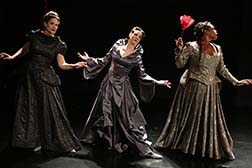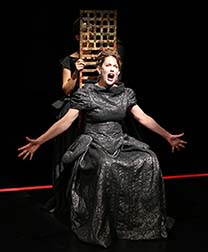
Lucy
Komisar
|
“Texts&beheadings/ElizabethR” is Karin Coonrod’s brilliant feminist take on Queen Elizabeth I
“Texts&beheadings/ElizabethR.” In this stunning artistic and feminist biography of Elizabeth I, Karen Coonrod tells us what most of us never knew about that 16th-century British monarch. She was first of all very, very smart, in politics. She was also studied and intelligent, poetic in her speaking and writing, and a polyglot – we hear her speak Italian, Spanish, German. She was subtle, but tough when it mattered. From Coonrod’s plays, built from Elizabeth’letters, speeches, poems, and prayers, you feel you are meeting an amazing woman!
The play starts with four gold high ladder-backed chairs set within a red rectangle painted on a black floor. (Set by John Conklin.) Four woman arrive, in steel gray or silver or black gowns. There’s a background noise like radio interference, or is it a mob? They speak across each other or sometimes join as a chorus. The play is divided into four movements, as if in a musical piece. Which it sometimes it is, with music – folk of the times or oratorio — by Gina Leishman. Each actor is Elizabeth in one of the movements, which are arranged by theme, not chronology in her life..
In the first movement, Strategy, Elizabeth (Cristina Spina, with an Italian charm and accent) dances a court dance. “Let tyrants fear,” she declares. Just before her coronation, John Knox in Geneva writes, “To promote a woman to bear rule, superiority, dominion, or empire above any realm, nation, or city, is repugnant to nature, the subversion of good order, of all equity and justice.” It is printed in his pamphlet, “The First Blast of the Trumpet Against the Monstrous Regiment of Women.”
Well! There are rumors of Elizabeth as oversexed, with bastards in hiding. Parliament pushes her to marry. She declares, “I will have no mistress, no master, no war.” It’s an Elizabeth we didn’t know. There’s a poetry slam with Walter Raleigh. And the Pope excommunicates her! Between the “movements” are “games.” The first is a droll put-down of the comic suitors, with various named nobles arriving, some goose stepping, holding red paper flowers.
Elizabeth (Monique Barbee) in movement 2 must achieve Survival. At 21, she is kept prisoner in the Tower by her cousin, Mary, Queen of Scots. She thinks she will die in the Tower like her mother, Anne Boleyn, beheaded by her father Henry. Game 2, she is in mourning for her father, and in a garden, birds slash her black dress to ribbons.
In movement 3, Prayers, Ayeje Feamster offers them in Spanish. The four kneel and sing a poetic “Mirabile” as a cantata. Sometimes Feamster’s black accent comes through, deliberately. Game 3 Dissing Elizabeth calls up the sound of voices as in stadium. The attacks printed on red papers are handed out to the audience.
Pope Pius V in a Papal Bull denouncing her in 1570 called her “…the pretended Queen of England, the serpent of wickedness…” “Oh Lord, the Queen’s a woman!” said an astonished housewife at the Coronation Passage of Elizabeth in January 1559. “She must have a hundred thousand devils in her body,” said the Bishop de Quadra, who handled marriage negotiations on behalf of Archduke Charles of Austria in 1563. The snide Catherine de Medici declared, “After what everyone tells me of her great beauty, and after the paintings I have seen, I must declare that she did not have good painters.” But hear this view by Pope Sixtus V: “She certainly is a great Queen, and were she only a Catholic, she would be our dearly beloved daughter. Just look how well she governs! She is only a woman, only mistress of half an island, and yet she makes herself feared by Spain, by France, by the Empire, by all…what a wife she would make! What children we would have! They would have ruled the whole world!” Movement 4, is, aha! Sovereignty! Here the very regal Juliana Francis-Kelly is Queen.
Dealing with Mary, she refuses to kill her. You have “attempted to take my life and to bring my kingdom to destruction by bloodshed.” She will keep her imprisoned but alive for almost two decades. As a monarch, Elizabeth is fearless, tough. In a letter to a courtier who complements her on her command of foreign languages, she says hold your tongue. And she declares, “I am more afraid of making a fault in my Latin than of the kings of Spain, France, Scotland and the whole house of Guise,” a French ducal family. Game 4 is dressing for the coronation. As piece after piece of skirt and bodice and jewelry is (figuratively) thrown on, you get a sense of how heavy was her obligation. The four actors are excellent, each providing a different mood, interpretation of Elizabeth. And Coonrod directs/conducts the production like a symphony of words, movement, music. What a view Coonrod gives us of a masterful woman who fought and rose above the sexism of the time (of all time) to exercise her power. What great imagination and talent Coonrod has. Her play deserves a much wider audience. |
| museums | NYTW mail | recordings | coupons | publications | classified |





